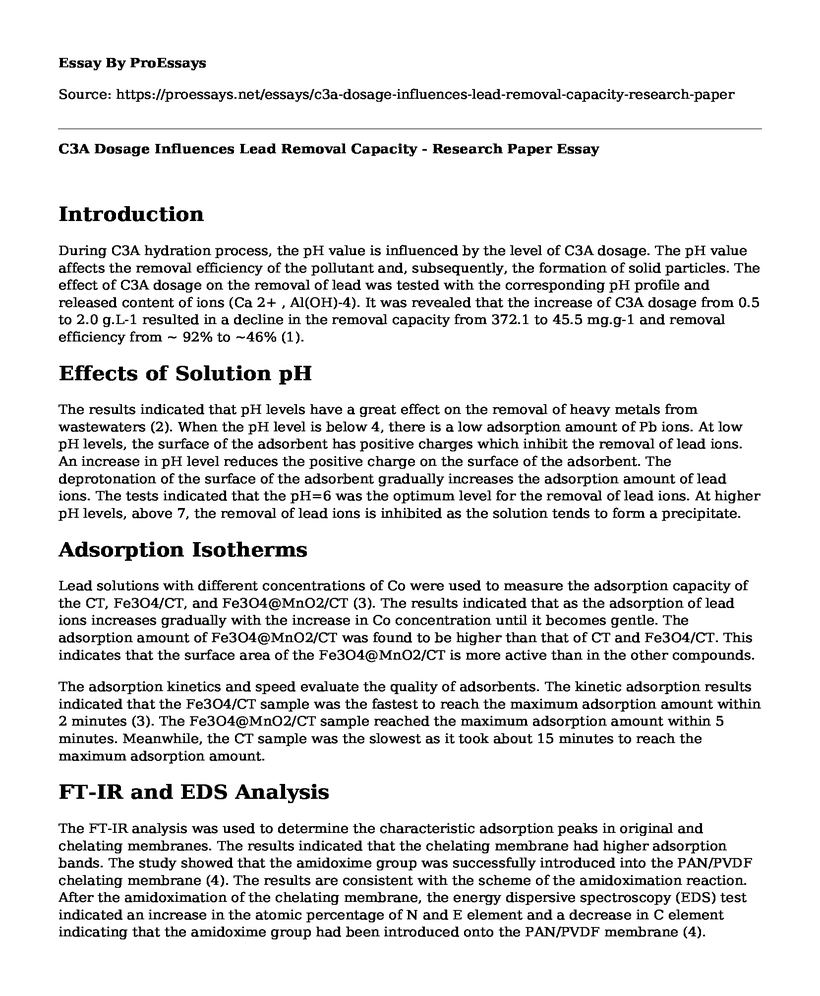Introduction
During C3A hydration process, the pH value is influenced by the level of C3A dosage. The pH value affects the removal efficiency of the pollutant and, subsequently, the formation of solid particles. The effect of C3A dosage on the removal of lead was tested with the corresponding pH profile and released content of ions (Ca 2+ , Al(OH)-4). It was revealed that the increase of C3A dosage from 0.5 to 2.0 g.L-1 resulted in a decline in the removal capacity from 372.1 to 45.5 mg.g-1 and removal efficiency from ~ 92% to ~46% (1).
Effects of Solution pH
The results indicated that pH levels have a great effect on the removal of heavy metals from wastewaters (2). When the pH level is below 4, there is a low adsorption amount of Pb ions. At low pH levels, the surface of the adsorbent has positive charges which inhibit the removal of lead ions. An increase in pH level reduces the positive charge on the surface of the adsorbent. The deprotonation of the surface of the adsorbent gradually increases the adsorption amount of lead ions. The tests indicated that the pH=6 was the optimum level for the removal of lead ions. At higher pH levels, above 7, the removal of lead ions is inhibited as the solution tends to form a precipitate.
Adsorption Isotherms
Lead solutions with different concentrations of Co were used to measure the adsorption capacity of the CT, Fe3O4/CT, and Fe3O4@MnO2/CT (3). The results indicated that as the adsorption of lead ions increases gradually with the increase in Co concentration until it becomes gentle. The adsorption amount of Fe3O4@MnO2/CT was found to be higher than that of CT and Fe3O4/CT. This indicates that the surface area of the Fe3O4@MnO2/CT is more active than in the other compounds.
The adsorption kinetics and speed evaluate the quality of adsorbents. The kinetic adsorption results indicated that the Fe3O4/CT sample was the fastest to reach the maximum adsorption amount within 2 minutes (3). The Fe3O4@MnO2/CT sample reached the maximum adsorption amount within 5 minutes. Meanwhile, the CT sample was the slowest as it took about 15 minutes to reach the maximum adsorption amount.
FT-IR and EDS Analysis
The FT-IR analysis was used to determine the characteristic adsorption peaks in original and chelating membranes. The results indicated that the chelating membrane had higher adsorption bands. The study showed that the amidoxime group was successfully introduced into the PAN/PVDF chelating membrane (4). The results are consistent with the scheme of the amidoximation reaction. After the amidoximation of the chelating membrane, the energy dispersive spectroscopy (EDS) test indicated an increase in the atomic percentage of N and E element and a decrease in C element indicating that the amidoxime group had been introduced onto the PAN/PVDF membrane (4).
Discussion
Mechanism of Pb Removal by C3A
The removal of Pb is achieved by precipitation and flocculation processes. To remove lead from waste waters, C3A particles are mixed with the Pb solution (1). The removal behavior is influenced by the initial Pb concentration and C3A dosages. At low Pb concentration, the hydration of C3A releases amorphous aluminum, which aids in the removal of lead ions. At high Pb concentration, the flocculation by the released amorphous aluminum improves the removal of lead ions.
To make clear the removal mechanism, the chemical precipitation thermodynamic mechanism was used to calculate the theoretical efficiency at equilibrium. The experimental data was consistent with the results of the precipitation model. The consistency in the tendency of the removal efficiency indicated that the isolation of lead ions is ascribed to precipitation. However, a notable variation between the calculated removal efficiency and the experimental data suggests the possibility of another interaction between C3A and Pb, aside from precipitation. The flocculation by amorphous aluminum hydroxide (Al(OH)-4) is the other possible removal mechanism. The level of the Al (OH)-4 is low in the experiment confirming the presence of amorphous aluminum hydroxide elements in the solid product. The experimental data and the calculated efficiency confirm that the removal of Pb from waste water is attributed mainly to precipitation and flocculation by amorphous aluminum hydroxide.
Factors Influencing the Adsorption Process
The treatment of waste water is complicated by the presence of natural organic matter, competing ions, high concentration of salts, and temperature. The presence of competing ions such as Ni 2+, Mg 2+, Zn 2+, and Ba 2+ affects the selective adsorption for Pb2+(3). Sewage water has a higher concentration of the salt solution, which has an effect on the adsorption of lead ions. The increase in the concentration of salt solution reduces the adsorption amount of Pb 2+ due to the competition of sodium and potassium ions for the adsorption site. The presence of humic acid (HA) in waste water significantly reduces the adsorption of lead ions due to the high deposits of carboxyl groups which compete with Pb 2+ ion for the adsorption site (3). Notably, the adsorbent worked regularly at different temperatures indicating no apparent influence.
Cite this page
C3A Dosage Influences Lead Removal Capacity - Research Paper. (2023, May 18). Retrieved from https://proessays.net/essays/c3a-dosage-influences-lead-removal-capacity-research-paper
If you are the original author of this essay and no longer wish to have it published on the ProEssays website, please click below to request its removal:
- Anatomy and Physiology-Myocardial Infarction
- Genetics in Treating and Developing Cancer Paper Example
- Research Paper on Uniting to Thwart the Worldwide Extinction Crisis
- Genetic Inheritance and the Function of DNA
- Essay Sample on Biomes: Temperate Forests & Tropical Rainforests
- Paper Sample on Cytokinins: Key Regulators of Plant Development and Metabolism
- Essay Example: Non-Renewable Resource Depletion & Sustainable Development Models







